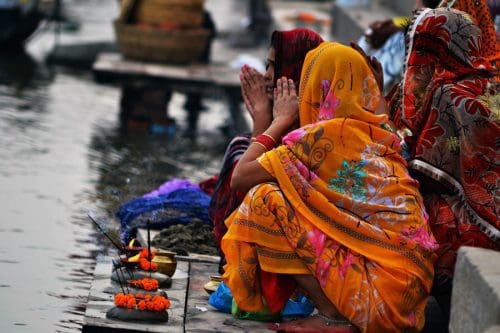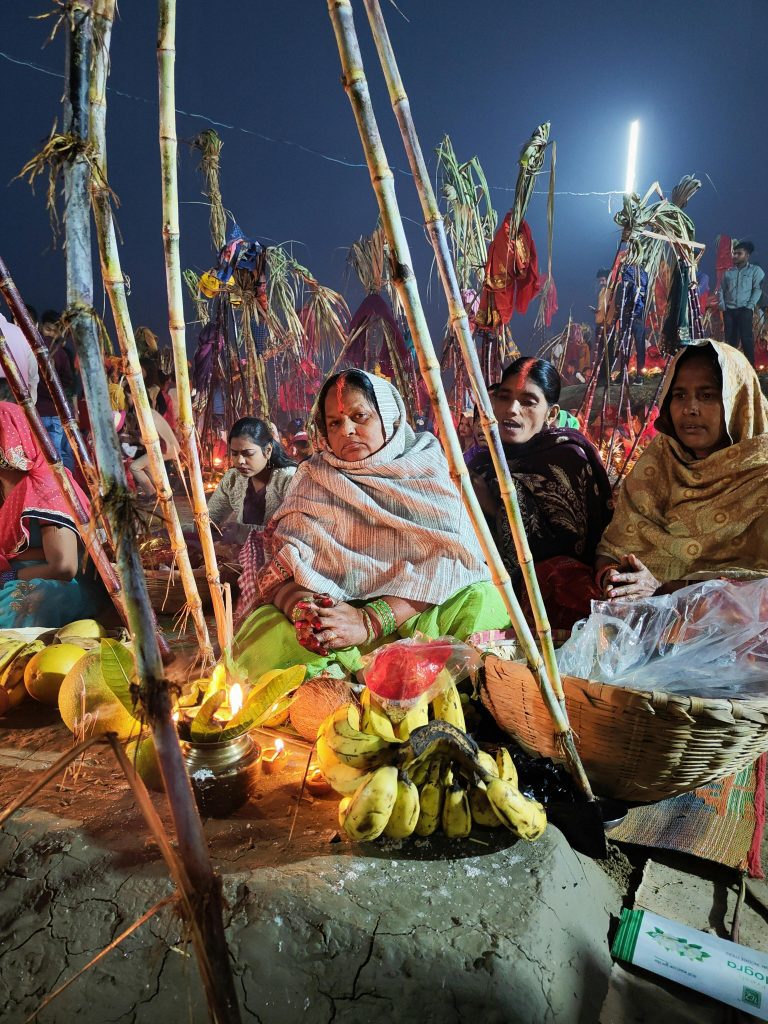Chhath Puja Purvanchal Mahaparv is a beautiful celebration of the deep bond between humanity and nature, bringing Bihar’s rich cultural heritage to life.
Through ancient rituals and heartfelt traditions, this festival honours the Sun God, expressing gratitude for life’s blessings and prosperity. The festival represents the cycle of life, with the evening sun symbolizing death and the morning sun symbolizing rebirth, highlighting our enduring connection to nature.
Chhath’s timeless customs unite communities, creating a shared devotion that transcends generations. More than a religious observance, it’s a celebration of harmony between families, communities, nature, and the divine.

Chhath Puja: a unique and powerful celebration of the Sun God
What makes a festival stand out from the countless others across India’s vibrant cultural landscape? In the case of Chhath Puja, it’s the deep connection between people and nature. This ancient festival, especially popular in Bihar, is dedicated to the Sun God, Surya, and his consort, Usha. What’s truly special about Chhath is that it’s celebrated outdoors, on the banks of rivers or other water bodies, where devotees offer prayers to the setting and rising sun, symbolizing the endless cycle of life.
What also makes this festival stand out is its simplicity. There are no grand processions or extravagant rituals—just pure devotion. Millions of people across India and the world take part, making it a deeply personal expression of faith, strength, and gratitude. For the people of Bihar, Chhath is more than just a religious observance; it reflects the deep bond they share with nature and their community.
Let’s explore and understand the rituals and significance that make Chhath Puja such a unique and powerful celebration.

The Origins of Chhath Puja: An Ancient Festival Rooted in Nature
The history of Chhath Puja is ancient, with references to the festival found in the Rig Veda, one of the oldest known scriptures in human history. The Vedic rituals performed during Chhath were originally meant to thank the Sun God for sustaining life on Earth and to seek his blessings for prosperity and well-being.
The festival is unique in its worship of natural elements—primarily the Sun (Surya), water, and earth. Unlike many other Hindu festivals that involve elaborate temple rituals, Chhath is observed along riverbanks and other water bodies, under the open sky. This closeness to nature highlights the deep ecological and environmental consciousness embedded in the festival’s rituals.
The mythology surrounding Chhath is also fascinating. According to Hindu legends, Chhath Puja was first performed by Karna, the son of Surya, who is one of the central figures in the epic Mahabharata. Another legend ties Chhath to Draupadi and the Pandavas, who performed the ritual to regain their kingdom. These stories emphasize the power of the Sun God and the significance of Chhath as a path to strength, prosperity, and spiritual awakening.
There’s another popular story about King Priyavrata, the son of the first Manu, Svayambhu. He was very sad because he and his wife, Queen Malini, had no children. Following the advice of the sage Kashyapa, the king performed a special yajna (ritual) to pray for a son. Soon after, Queen Malini gave birth to a baby, but sadly, the child was born lifeless. The royal family was heartbroken.
In their moment of despair, the goddess Shashthi appeared in the sky. She introduced herself as Chhathi Maiya, the sixth form of Goddess Parvati, and said, “I protect all children and bless those who are childless.” With her divine touch, she brought the baby back to life. Filled with gratitude, King Priyavrata worshipped Chhathi Maiya, and it is believed that this marked the beginning of Chhath Puja, which eventually became a widespread tradition.
The Rituals of Chhath Puja
Chhath Puja spans over four days, with each day carrying a deep symbolic meaning that reflects the devotees’ journey towards spiritual purity. What makes this festival even more special is the involvement of the entire family and community. Every ritual is carried out with utmost dedication, creating an atmosphere of harmony and shared devotion.
Day 1: Nahay Khay (Bathing and Eating)
The first day of Chhath Puja marks the beginning of the devotees’ spiritual cleansing. On this day, devotees bath in holy rivers, usually the Ganges or local water bodies, and bring home water to prepare offerings. The home is thoroughly cleaned, symbolizing the removal of impurities. The meal prepared on this day is simple, often consisting of rice, dal, and pumpkin collectively called Kadua-Bhaat , cooked without garlic or onions to maintain purity. This day sets the tone for the rigorous fasting that will follow.
Day 2: Kharna
The second day of Chhath is marked by rigorous fasting and purification. Devotees observe a full-day fast without even drinking water, symbolizing self-discipline and spiritual cleansing. The fast is broken after sunset with a simple meal known as “prasad,” typically consisting of jaggery kheer (rice pudding), chapati, and bananas, prepared without salt, onion, or garlic to maintain purity. The prasad is shared with family and neighbours, signifying communal harmony. After Kharna, devotees begin a 36-hour fast without water, leading to the main rituals of offering prayers to the Sun God.
Day 3: Sandhya Arghya (Evening Offerings)
The third day is the most significant part of Chhath. The Chhath Puja special is Thekua – a traditional sweet cum offering made during the Puja. It’s prepared by mixing wheat flour, jaggery, and ghee into a dough, flavoured with fennel seeds or coconut. The dough is shaped into discs, often with patterns, and deep-fried in ghee until golden. Thekua is crunchy, flavourful, and long-lasting, making it an important offering and snack during the festival.

As the sun begins to set, devotees gather at riverbanks or water bodies to offer their prayers to the setting sun. The ritual involves standing in knee-deep water and holding offerings in bamboo baskets made of fruits, sugarcane, and Thekua. The act of worshipping the setting sun, which is considered a symbol of ageing, is a beautiful reminder of the cycle of life and death, and the importance of both ends of the spectrum.
Chhath is one of the few festivals that worship the setting sun, representing the idea that life’s journey involves both highs and lows, and both must be respected equally. The Sandhya Arghya is a mesmerizing sight, with thousands of devotees offering their prayers simultaneously, creating a sense of unity and reverence for nature.

Day 4: Usha Arghya (Morning Offerings)
The final day of Chhath Puja begins before dawn, with devotees returning to the riverbanks to offer their prayers to the rising sun. The morning Arghya is a moment of hope, as devotees thank the Sun God for sustaining life and seek blessings for their families and communities. After the prayers, the fast is broken, and the Prasad is distributed among family members, neighbours, and friends.
The Usha Arghya signifies renewal, optimism, and gratitude. The rituals performed during these two days symbolize the cycle of life—death (evening sun) and rebirth (morning sun)—and our constant connection to the natural world around us.
Chhath Puja and Its Cultural Significance in Bihar
For the people of Bihar, Chhath is more than just a religious observance; it’s an integral part of their cultural identity. The festival unites people across socioeconomic backgrounds, fostering a sense of community and mutual respect. Families come together to prepare for the festival days in advance, cleaning their homes, preparing offerings, and decorating the puja site.
One of the most striking aspects of Chhath Puja is the role of women in the festival. While both men and women participate, it is often the women who undertake the fasts and lead the rituals. This gives Chhath a unique position among Indian festivals, as it empowers women as spiritual leaders within their families and communities.
Chhath Puja also emphasizes the values of simplicity and purity. The offerings used during the festival are humble—fruits, sugarcane, and Thekua- “highlighting the idea that devotion lies not in the grandeur of the offerings, but in the purity of the heart”.
The sight of thousands of devotees standing in rivers, hands raised to the sky in prayer, speaks volumes about the deep connection the people of Bihar have with nature. Chhath serves as a reminder of the sacredness of water, land, and sunlight—essential elements that sustain all life on Earth. In a time when environmental consciousness is more important than ever, Chhath Puja offers a glimpse into an ancient practice that celebrates the balance between human beings and the natural world.
Chhath Puja Beyond Bihar: A Growing Tradition Worldwide
While Bihar remains the heart of Chhath Puja celebrations, the festival has spread far beyond its borders. With the migration of Biharis to other parts of India and the world, Chhath is now observed in cities as far-flung as Delhi, Mumbai, and Kolkata, and even internationally in countries like Nepal, Mauritius, and the United States.
In urban centres, the festival has adapted to modern surroundings, with artificial ponds being created to accommodate devotees. Despite the changing environment, the spirit of Chhath Puja remains unchanged—devotion, purity, and reverence for nature continue to guide the festival’s observance.
Chhath Puja: A Celebration of Unity, Humility, and Gratitude
Chhath Puja goes beyond religious rituals, teaching important values of humility, gratitude, and community. In today’s fast-paced, individualistic world, this festival brings people together—families, neighbours, and even strangers—breaking barriers of caste and community through shared devotion. The simplicity and humility of the rituals remind us that kindness and human connection are at the core of meaningful celebrations.
For the people of Bihar and beyond, Chhath is more than a religious observance; it’s a celebration of life. The rituals of worshipping the setting and rising sun reflect nature’s eternal cycles, reinforcing values like faith, hope, and gratitude that sustain human existence.
FAQs on Chhath Puja: Rituals, Significance, and Dates
- What is Chhath Puja? Chhath Puja is a celebration that honours the Sun God, Surya, and expresses gratitude for life, prosperity, and the natural elements.
- What is the meaning of “Chhath”? Chhath” refers to the number six, as the festival is celebrated on the sixth day of the Kartika month in the Hindu calendar. It is also known as Surya Shashti.
- What are the main offerings during Chhath Puja? Devotees offer fruits, thekua (a traditional sweet made of wheat and jaggery), sugarcane, and coconuts to the Sun God during the prayers at sunset and sunrise.
- Why do people stand in the water during Chhath Puja? Standing in water symbolizes the purification of the body and soul. It is also a way to show deep reverence to nature and the Sun God, as water is considered a sacred element.
- How is Chhath Puja different from other Hindu festivals? Unlike other festivals, Chhath does not involve elaborate idol worship or rituals in temples. Instead, it focuses on worshipping natural elements like the Sun and water, and devotees observe extremely strict fasts.
- How long does Chhath Puja last, and what are the main rituals? Chhath is a four-day festival. The main rituals include fasting, taking holy dips in rivers or water bodies, offering prayers to the Sun during sunrise and sunset, preparing offerings without salt, onion, or garlic, and offering prasad with simple ingredients, all aimed at purifying the body and soul.
- When is Chhath Puja celebrated? Chhath Puja is celebrated twice a year—once in the summer after Holi, known as Chaiti Chhath, and once in the winter, known as Karthik Chhath, which falls on the 6th day of the Karthika month (usually in October or November).
- Where is Chhath Puja primarily celebrated? Chhath Puja is widely celebrated in Bihar, where it is a major festival. Other states like Uttar Pradesh, Madhya Pradesh, Jharkhand and Chhattisgarh also celebrate it.
- What are the dates for Chhath Puja 2024 and 2025? In 2024, Chhath Puja will be observed on November 7th, while in 2025, it will fall on October 25th.
Read more: Latest



